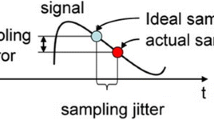Abstract
In wireless sensor networks, collected data usually have a certain degree of loss and are unable to meet actual application needs due to node failures or energy limitation, etc. The current data recovery methods in wireless sensor networks focus on the usage of spatial–temporal correlation between perceptual data but seldom exploit the correlation between different attributes. This paper proposes a data recovery algorithm based on the Attribute Correlation and Extremely randomized Trees (ACET). Firstly, the Spearman’s correlation coefficient is adopted to construct the correlation model between different attributes. In case that a given attribute is lost, the correlation model is used to select other attributes that have a strong correlation with this attribute, and then take advantage of them to train the extremely randomized trees. Finally, the lost data can be recovered by the trained model. Experimental results show that the correlation between attributes can improve the effectiveness of data recovery compared with other methods.













Similar content being viewed by others
References
Akyildiz IF, Su W, Sankarasubramaniam Y et al (2002) Wireless sensor networks: a survey. Comput Netw 38(4):393–422
Candes EJ, Romberg J, Tao T (2006) Robust uncertainty principles: exact signal reconstruction from highly incomplete frequency information. IEEE Trans Inf Theory 52(2):489–509
Chen G, Liu X, Kong L, et al (2013) JSSDR: Joint-sparse sensory data recovery in wireless sensor networks. In: IEEE international conference on wireless & mobile computing. IEEE, pp 367–374
Chen W, Xiao P, Yu Z, et al (2018) The recovery algorithm of saturated sar raw data based on compressed sensing. In: IGARSS 2018–2018 IEEE international geoscience and remote sensing symposium, pp 8018–8021
Chen J, Jia J, Deng Y et al (2018b) Adaptive compressive sensing and data recovery for periodical monitoring wireless sensor networks. Sensors (Basel, Switzerland) 18(10):1–17
Chen C, Ding Y, Xie X, et al (2019) TrajCompressor: an online map-matching-based trajectory compression framework leveraging vehicle heading direction and change. In: IEEE transactions on intelligent transportation systems, to appear
Cheng H, Wu L, Zhang Y, et al (2018) Data recovery in wireless sensor networks using Markov random field model. In: 2018 tenth international conference on advanced computational intelligence (ICACI). IEEE, pp 706–711
Donoho DL (2006) Compressed sensing. IEEE Trans Inf Theory 52(4):1289–1306
Geurts P, Ernst D, Wehenkel L (2006) Extremely randomized trees. Mach Learn 63(1):3–42
Gong L, Zhao Y, Chaocan X et al (2018) Robust light-weight magnetic-based door event detection with smartphones. IEEE Trans Mob Comput. https://doi.org/10.1109/TMC.2018.2876841
Guo S, Chen C, Liu Y et al (2019) ROD-Revenue: seeking strategies analysis and revenue prediction in ride-on-demand service using multi-source urban data. In: IEEE transactions on mobile computing (TMC), to appear
He J, Sun G, Zhang Y et al (2015) Data recovery in wireless sensor networks with joint matrix completion and sparsity constraints. IEEE Commun Lett 19(12):2230–2233
Huang M, Liu W, Wang T et al (2019) A queuing delay utilization scheme for on-path service aggregation in services oriented computing networks. IEEE Access 7(1):23816–23833
Intel (2019) Intel Lab Data[EB/OL]. (2004-6-2) [2019-01-17]http://db.csail.mit.edu/labdata/labdata.html. Accessed 17 Jan 2019
Kamalesh S, Ganesh Kumar P (2017) Data aggregation in wireless sensor network using SVM based failure detection and loss recovery. J Exp Theor Artif Intell 29(1):133–147
Kohei O, Yoshihiro Y, Koji K, et al (2016) Environmental data recovery using polynomial regression for large-scale wireless sensor networks. In: SENSORNETS 2016. 5th international conference on sensor networks, pp 161–168
Mo L, He Y, Liu Y, et al (2009) Canopy closure estimates with GreenOrbs: sustainable sensing in the forest. In: SenSys 09: proceedings of the 7th ACM conference on embedded networked sensor systems
Pattem S, Krishnamachari B, Ramesh G (2004) The impact of spatial correlation on routing with compression in wireless sensor networks. In: International symposium on information processing in sensor networks. IEEE, pp 28–35
Roberto M, Jose C, Pedro G (2015) Multivariate statistical approach for anomaly detection and lost data recovery in wireless sensor networks. Int J Distrib Sens Netw 2015:1–20
Shabir AS, Roohie, Naaz M (2017) Natural algorithm based adaptive architecture for underwater wireless sensor networks. In: 2017 international conference on wireless communications, signal processing and networking (WiSPNET), pp 2343–2346
Slim R, Mounira O, Boularbah S (2018) SAR Images Compressed Sensing Based on Recovery Algorithms. In: IGARSS 2018–2018 IEEE international geoscience and remote sensing symposium, pp 8897-8900
Song W, Huang R, Xu M et al (2010) Design and deployment of sensor network for real-time high-fidelity volcano monitoring. IEEE Trans Parallel Distrib Syst 21(11):1658–1674
Vuran MC, Akyildiz IF (2006) Spatial correlation-based collaborative medium access control in wireless sensor networks. IEEE/ACM Trans Netw 14(2):316–329
Wang J, Wang Y, Zhang D et al (2018) Multi-task allocation in mobile crowd sensing with individual task quality assurance. IEEE Trans Mob Comput 17(9):2101–2113
Wang J, Wang F, Wang Y et al (2019) Social-network-assisted worker recruitment in mobile crowd sensing. IEEE Trans Mob Comput 18(7):1661–1673
Acknowledgements
This work is supported by the National Natural Science Foundation of China under Grant No. 61772136 and 61370210, the Fujian Provincial Nature Science Foundation of China under Grant No. 2019J01245, the Fujian Collaborative Innovation Center for Big Data Application in Governments, the Fujian Engineering Research Center of Big Data Analysis and Processing.
Author information
Authors and Affiliations
Corresponding author
Ethics declarations
Conflict of interest
The authors declare that they have no conflict of interest.
Additional information
Publisher's Note
Springer Nature remains neutral with regard to jurisdictional claims in published maps and institutional affiliations.
Rights and permissions
About this article
Cite this article
Cheng, H., Wu, L., Li, R. et al. Data recovery in wireless sensor networks based on attribute correlation and extremely randomized trees. J Ambient Intell Human Comput 12, 245–259 (2021). https://doi.org/10.1007/s12652-019-01475-z
Received:
Accepted:
Published:
Issue Date:
DOI: https://doi.org/10.1007/s12652-019-01475-z




